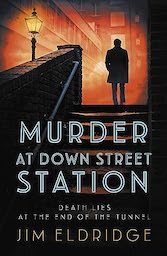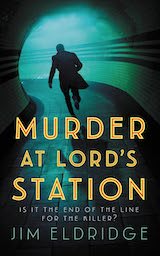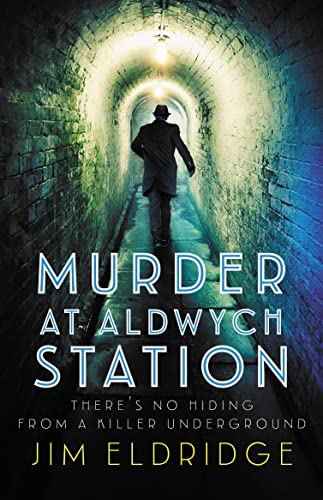
London’s more recent history, the last 100 years, especially, seems to be a constant theme. Is this a professional interest?
It is, also a personal interest. My family have been Londoners for over a hundred and fifty year, mostly based around the Camden Town/Kentish Town/Somers Town areas – long before they were gentrified in the 1980s. The Camden Town that I grew up in the late 1940s/1950s, had three nationalities of equal size: English, Irish, Greek Cypriot. Consequentially I grew up with a strong awareness of Irish and Cypriot history.
Many, possibly all, the locations in Murder at Whitechapel Road Station have changed beyond recognition. Do you have personal memories of post-war London in the 1950s?
I do, because I was born in November 1944 (the war ended in 1945) and so I grew up surrounded by bomb sites and bomb-damaged buildings. The reconstruction of Camden Town’s bomb damage started in the late 1950s and early 1960s. For example, I remember the old Euston station because on Cup Final day I used to hang around there asking for Cup Final programmes from the crowds leaving Euston.
DCI Coburg and DS Lawson are your long-term heroic detectives. Are they based on people you know or have met?
They are compilations of people I have known and admired from that time. For example, I am one of those who believe that the Attlee Government of 1945 was the best this country has ever known. I admire the way that Attlee was able to keep his very diverse Ministers together; the almost Communist Nye Bevan with the more right wing Ernie Bevin, for example. Although Bevan and Bevin hated one another, he got them to work together to rebuild the country. (When someone said to Bevin that Nye Bevan was his own worst enemy, Bevin replied: “Not while I’m alive he isn’t.)
This is the fourth ‘Murder at’ a London Underground station. Are you planning to write more? There are hundreds to explore.



There are, but after discussion with my publishers, Allison & Busby, we’ve decided to add a different setting – Cathedrals. You may remember that the first three Coburg books were set in hotels, MURDER AT THE RITZ, MURDER AT THE SAVOY and MURDER AT CLARIDGES, before we switched to abandoned Underground stations. So, the next Coburg book will be MURDER AT ST PAUL’S CATHEDRAL, and then I’m planning MURDER AT CANTERBURY CATHEDRAL and MURDER AT ELY CATHEDRAL.
There are some historical, political statements in this book. Are the politics of that era of particular interest for you?
The politics certainly are. It would have been hard to avoid them growing up in the Borough of St Pancras (now Camden). For example, St Pancras Borough Council was the only one in London that on May Day flew the red flag over the town hall rather than the Union Jack.
Your writing career took off well over half a century ago. Is it more satisfying to write for broadcast or crime fiction?
I often think of my time as a scriptwriter (250 TV scripts and 250 radio scripts broadcast) with great fondness. It was a wonderful time working with wonderful people. But the time came when I felt that the worlds of TV radio and film had become very different to what I’d enjoyed – hence my move to writing novels. I absolutely love doing what I’m doing now.
I’ve been very lucky to find a company like Allison and Busby who have been 100% supportive and encouraging, so writing is still a great pleasure for me.
Would you offer any advice to world-be authors and those wishing to make creative writing a career?
Try everything that’s offered to you. Enjoy the research if it’s new for you. For example, I’d never been involved in writing books about the War until – when I was writing children’s books – a publisher asked me if I’d be interested in writing fiction about the second world war, and another asked if I’d be interested in writing fiction about the war in the trenches during WW1. I did them both, and both series of books went on to sell very well indeed. As a scriptwriter I’d written historical tales, sci-fi, fantasy, educational TV, situation comedy, adapted films into novels, ghosted biographies, sketch shows, soap operas, and learnt so much from each – and how to develop myself as a writer.
You could have ‘hung up your pen’ years ago, but you have chosen to keep writing and stay in the angst-ridden world of being a published author. Why?
Basically, it’s who I am. It keeps me going, keeps my brain ticking over. And I love it.
The story involving Coburg’s jazz musician wife, Rosa, plays heavily on the stars of the period and their roles in keeping up the nation’s spirits during those war years. Was this something you researched for actual appearances?
Yes. Entertainment of the war years has long fascinated me. In my radio career I wrote and worked with some of those who’d been radio stars during the war (e.g. Deryck Guyler) or film stars (e.g. John Laurie) and I used to sit with them and lap up their tales of working with so many of my heroes. I worked with the genius TV producer, Denis Main Wilson (Hancock’s Half Hour, The Goon Show, Till Death Do Us Part, who produced my first TV sitcom). Denis was in military action during WW2, as were Spike Milligan and Harry Secombe of the Goons.
While a scriptwriter I also worked at the old Ealing film studios after BBC TV had taken them over. So lots of contacts with and memories of those entertainment heroes from that time.

Allison & Busby
RRP: £22.00
Released: November 21, 2024
Read our review